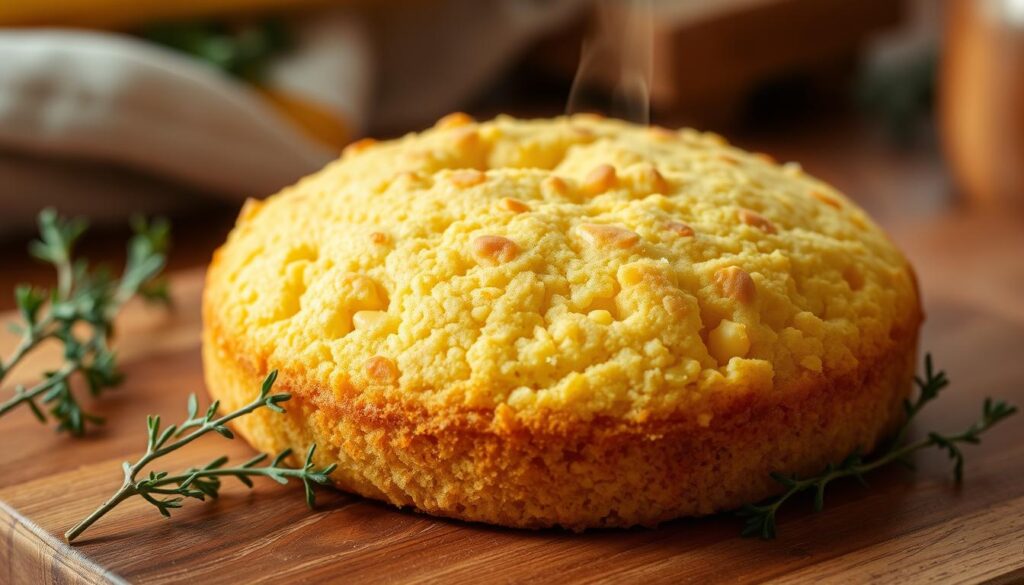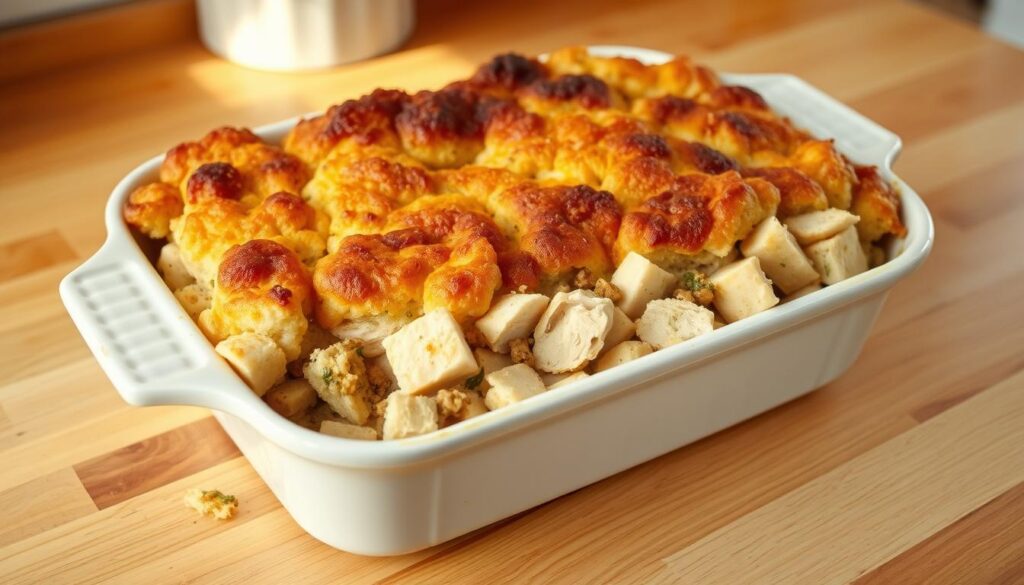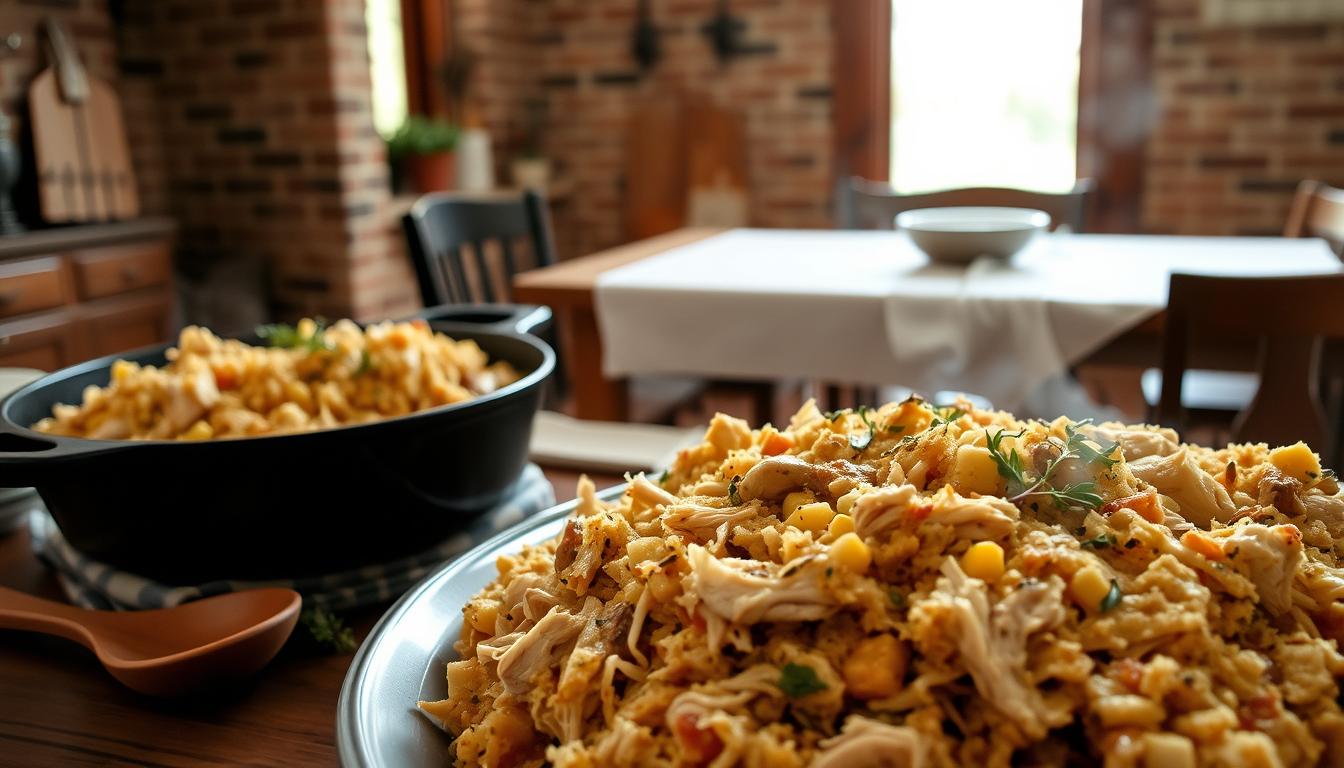Southern cuisine boasts many beloved dishes, but homemade chicken and dressing stands out as a true culinary treasure. This classic comfort food represents more than just a meal—it’s a celebration of family tradition and cultural heritage. Your journey into mastering the perfect recipe for homemade chicken and dressing begins here at luyarecipes.com.
When you explore this time-honored dish, you’ll discover why generations of home cooks have cherished its rich flavors and heartwarming qualities. Chicken and dressing isn’t simply a side dish; it’s a centerpiece that brings families together during holidays and special gatherings across the Southern United States.
Key Takeaways
- A quintessential Southern comfort food with deep cultural roots
- Requires skill and tradition to prepare perfectly
- More than a recipe—a family legacy
- Versatile dish suitable for multiple occasions
- Represents genuine home cooking techniques
The History and Heritage of Southern Chicken and Dressing
Southern cuisine tells a rich story of comfort and tradition. The delicious homemade chicken and dressing emerged from a culinary landscape deeply rooted in family gatherings and resourceful cooking. Settlers and home cooks transformed simple ingredients into a beloved dish that continues to warm hearts across generations.
Roots in Southern Kitchen Culture
Traditional homemade chicken and dressing began as a practical way to use leftover bread and poultry. Farm families developed recipes that stretched ingredients while creating satisfying meals. The dish represented resourcefulness and creativity in Southern kitchens.
Family Recipe Transformations
Each generation added its own twist to the classic recipe. Grandmothers passed down cooking techniques, ensuring the delicious homemade chicken and dressing maintained its core essence while adapting to changing tastes and available ingredients.
Regional Culinary Influences
“A recipe is a story that ends with a meal.” – Unknown Southern Chef
Different Southern regions brought unique flavors to traditional homemade chicken and dressing. Coastal areas might add seafood elements, while inland communities focused on farm-fresh ingredients. These variations showcase the dynamic nature of Southern cooking.
Understanding the rich history behind this dish helps you appreciate more than just its incredible taste. It connects you to generations of family traditions and culinary innovation.
Essential Ingredients for Perfect Homemade Chicken and Dressing
Creating the best homemade chicken and dressing from scratch starts with selecting high-quality ingredients. Your success depends on choosing fresh, flavorful components that work together harmoniously. The foundation of an exceptional dish lies in understanding each ingredient’s role and potential.
“Great cooking is about ingredients and how you combine them.” – Wolfgang Puck
For your homemade chicken and dressing, start with premium bread. Cornbread works best, offering a rich, slightly sweet base that absorbs flavors beautifully. Stale bread or day-old cornbread provides ideal texture and helps create that classic southern comfort food experience.
Fresh herbs elevate your chicken and dressing from scratch. Sage, thyme, and parsley bring depth and complexity. Freshly chopped herbs beat dried alternatives every time. Chicken stock is another critical ingredient – homemade or high-quality store-bought stock can transform your dish from good to extraordinary.
Your seasoning blend matters significantly. Salt, black pepper, and poultry seasoning form the core of traditional recipes. Don’t be afraid to experiment with additional spices like rosemary or marjoram to personalize your best homemade chicken and dressing.
Remember, quality ingredients make all the difference. Invest in fresh, local produce and take time to select each component carefully. Your taste buds will thank you for the extra effort.
Choosing and Preparing the Perfect Chicken
Creating an easy homemade chicken and dressing starts with selecting the right poultry. Your chicken choice can make or break the entire dish, transforming a simple meal into a memorable culinary experience.
Selecting Quality Poultry
When preparing a homemade chicken and dressing casserole, opt for fresh, high-quality chicken. Bone-in, skin-on chicken thighs offer the most flavor and tenderness. Free-range or organic chickens typically provide richer taste and better texture for your dish.
Proper Seasoning Techniques
Seasoning is crucial for delicious chicken. Create a blend of salt, black pepper, garlic powder, and dried herbs like thyme or rosemary. Pat the chicken dry before seasoning to ensure the spices adhere perfectly and create a delightful crust.
“The secret to great chicken is in the seasoning and cooking method.” – Southern Kitchen Wisdom
Cooking Methods for Tender Results
For an easy homemade chicken and dressing, consider roasting or slow-cooking your chicken. Roasting at 375°F helps develop deep flavors while maintaining moisture. Alternatively, a slow cooker can create incredibly tender meat that falls apart effortlessly when mixed into your dressing.
Remember, the chicken’s preparation sets the foundation for an unforgettable homemade chicken and dressing casserole that will have everyone asking for seconds.
Making the Perfect Cornbread Base

Creating the perfect cornbread base is crucial for traditional homemade chicken and dressing. Your cornbread foundation sets the stage for a rich, flavorful dish that captures the essence of Southern cooking. The right cornbread can transform your homemade chicken and dressing with cornbread from good to unforgettable.
“Great dressing starts with great cornbread” – Southern Cooking Wisdom
Start with high-quality cornmeal – preferably stone-ground for authentic texture. Choose yellow or white cornmeal based on your family’s tradition. The key is achieving a balance between moisture and crumbly texture. Use buttermilk for tanginess and extra tenderness. A cast-iron skillet helps create that crispy golden crust essential to traditional homemade chicken and dressing.
Your cornbread mixture should combine cornmeal, flour, baking powder, salt, eggs, and buttermilk. Avoid overmixing, which can make the bread tough. Bake until the top is golden brown and a toothpick comes out clean. Let it cool completely before crumbling into your dressing – this helps absorb flavors and create the perfect consistency.
Professional Southern cooks know that cornbread isn’t just an ingredient – it’s the heart of a great chicken and dressing recipe. Your homemade version will shine with these time-honored techniques.
Secrets to Creating the Perfect Dressing Texture
Crafting the best homemade chicken and dressing requires mastering the art of texture. The difference between a good and great dressing lies in its consistency and moisture balance. Professional home cooks know that texture can make or break this classic dish.
Your recipe for homemade chicken and dressing should focus on achieving a delicate balance between moistness and structural integrity. The key is understanding how different ingredients interact to create the ideal texture.
Moisture Control Strategies
Controlling moisture is crucial in creating the perfect dressing. Start by using day-old bread or cornbread, which absorbs liquid without becoming soggy. Carefully measure your chicken broth or stock to prevent a wet, mushy result. A good rule of thumb is to add liquid gradually, allowing the mixture to reach a soft but not waterlogged consistency.
Mixing Techniques for Even Distribution
When preparing the best homemade chicken and dressing, gentle mixing is essential. Use a folding motion to combine ingredients, ensuring even distribution without compacting the mixture. This technique helps maintain a light, fluffy texture that makes your dressing truly memorable.
Achieving the Ideal Consistency
The perfect dressing should hold together when scooped but still have a soft, tender crumb. Check the consistency by pressing the mixture gently – it should feel moist but not wet. Your recipe for homemade chicken and dressing will shine when you master this delicate balance between moisture and structure.
“Texture is the secret language of great cooking.” – Professional Chef’s Wisdom
Step-by-Step Guide to Homemade Chicken and Dressing
Creating an easy homemade chicken and dressing from scratch might seem intimidating, but with the right approach, you can master this classic Southern dish. Start by preparing your chicken thoroughly. Choose a whole chicken or chicken pieces and season them with salt, pepper, and your favorite herbs.
“Cooking is love made visible” – Chef Anonymous
For your homemade chicken and dressing from scratch, begin by roasting or boiling the chicken until it’s tender and fully cooked. Shred the meat into bite-sized pieces. Next, prepare your cornbread base, which will serve as the foundation for your dressing. Use a cast-iron skillet for authentic Southern-style cornbread that adds rich flavor.
Mix your shredded chicken with crumbled cornbread, chopped celery, onions, and a blend of chicken broth and eggs. The key to perfect dressing is achieving the right moisture level. Your mixture should be moist but not soggy. Season generously with sage, thyme, and black pepper to enhance the traditional flavor profile.
Transfer the mixture to a baking dish and bake at 350°F for approximately 45 minutes. The top should turn golden brown, with a crispy exterior and a soft, flavorful interior. Want more visual guidance? Check out our step-by-step Pinterest board at pinterest.com/luyarecipes/ for additional tips and tricks.
Herb and Seasoning Combinations for Maximum Flavor
Creating a delicious homemade chicken and dressing requires more than just basic ingredients. The right blend of herbs and seasonings transforms an ordinary dish into a culinary masterpiece that will delight your taste buds and impress your dinner guests.
The secret to an exceptional traditional homemade chicken and dressing lies in understanding how different herbs complement each other. Southern kitchens have long celebrated classic herb combinations that bring depth and warmth to this beloved dish.
Classic Southern Herb Profiles
Sage stands as the cornerstone of traditional chicken and dressing. Its earthy, slightly peppery flavor provides a robust foundation. Pair it with thyme’s subtle minty notes and rosemary’s piney undertones to create a complex flavor profile that speaks to generations of Southern cooking.
Modern Flavor Explorations
While respecting tradition, contemporary cooks are experimenting with unexpected herb combinations. Consider adding a hint of dried lavender or a touch of fennel seed to your delicious homemade chicken and dressing for a unique twist that surprises and delights.
Balancing Aromatic Harmony
“Herbs are the soul of cooking, transforming simple ingredients into extraordinary meals.” – Chef Marcus Wright
The key to perfect seasoning is balance. Start with small amounts, tasting as you go. Remember that dried herbs are more concentrated than fresh, so adjust quantities accordingly. Your goal is a harmonious blend that enhances without overwhelming the natural flavors of chicken and cornbread.
Tips for Make-Ahead and Storage Options

Planning ahead can transform your homemade chicken and dressing casserole from a time-consuming meal to an easy homemade chicken and dressing solution. Preparing components in advance allows you to enjoy this classic dish with minimal last-minute stress.
“Prep work is the secret to stress-free cooking!” – Southern Kitchen Wisdom
For refrigerator storage, your homemade chicken and dressing casserole can be assembled up to 24 hours before baking. Cover the dish tightly with aluminum foil and store in the refrigerator. When you’re ready to serve, remove the casserole 30 minutes before baking to bring it to room temperature.
Freezing offers even more flexibility for your easy homemade chicken and dressing. Wrap the unbaked casserole securely in plastic wrap and then in aluminum foil. Most chicken and dressing casseroles can be frozen for up to one month. Thaw overnight in the refrigerator before baking.
Pro tip: Always label your stored casserole with the date and contents. This helps track freshness and prevents any confusion in your refrigerator or freezer.
When reheating leftovers, cover the dish with foil to prevent drying out. Warm at 350°F for about 15-20 minutes, or until the internal temperature reaches 165°F for food safety.
Common Mistakes to Avoid When Making Chicken and Dressing
Crafting the best homemade chicken and dressing requires skill and attention to detail. Even experienced home cooks can stumble when preparing this classic dish. Understanding potential pitfalls will help you perfect your recipe for homemade chicken and dressing.
Achieving the perfect texture is crucial when making chicken and dressing. Many cooks struggle with dryness or excessive moisture. The key is balancing your ingredients carefully. Too much broth can create a soggy mess, while too little results in a crumbly, unappetizing dish.
Texture Troubles and Fixes
Start by adding liquid gradually. Use a gentle touch when mixing your cornbread and chicken. If the mixture seems too dry, add chicken broth sparingly. For overly wet dressing, incorporate additional dry breadcrumbs to absorb excess moisture.
Seasoning Challenges
Seasoning can make or break your best homemade chicken and dressing. Under-seasoning leads to bland results, while over-seasoning overwhelms the dish. Taste your mixture before baking and adjust herbs and spices carefully.
Temperature Control Techniques
“Precise temperature is the secret to perfect chicken and dressing” – Southern Cooking Experts
Oven temperature plays a critical role in your recipe for homemade chicken and dressing. Cooking too hot can dry out the dish, while low temperatures prevent proper browning. Aim for 350-375°F and cover with foil to prevent excessive browning.
By avoiding these common mistakes, you’ll create a delicious chicken and dressing that will impress family and friends.
Serving Suggestions and Side Dish Pairings
Your delicious homemade chicken and dressing deserves accompaniments that elevate its rich flavors. Southern cuisine offers a wealth of classic side dishes that perfectly complement this traditional homemade chicken and dressing.
Green vegetables provide a fresh contrast to the hearty main dish. Roasted green beans with sliced almonds or buttered collard greens bring color and nutrition to your plate. Sweet potato casserole adds a touch of sweetness that harmonizes beautifully with the savory chicken and dressing.
“A great meal is about balance, and the right sides can transform a good dish into an unforgettable dining experience.” – Southern Cooking Wisdom
Consider classic Southern sides like mac and cheese, creamy coleslaw, or buttermilk biscuits. These options create a well-rounded meal that honors the comfort food tradition. For a lighter touch, a crisp green salad with tangy vinaigrette can cut through the richness of the chicken and dressing.
During holiday gatherings, cranberry sauce or jellied cranberries provide a tart complement. Gravy lovers might enjoy an extra ladle of homemade chicken gravy drizzled over the entire plate, enhancing the delicious homemade chicken and dressing with additional moisture and flavor.
Variations on Traditional Homemade Chicken and Dressing
Your homemade chicken and dressing with cornbread doesn’t have to be limited to a single recipe. Creative cooks can transform this classic comfort food into exciting new dishes that keep the core flavors while adding unique twists.
Regional adaptations offer exciting possibilities for your homemade chicken and dressing casserole. In coastal areas, chefs might incorporate fresh seafood like oysters or shrimp. Southwestern versions could include green chiles or jalapeños for a spicy kick. Vegetarian options can replace chicken with hearty mushrooms or roasted vegetables.
“Great cooking is about innovation while respecting traditional flavors” – Chef Marcus Samuelsson
Consider exploring gluten-free alternatives by using almond flour cornbread or quinoa-based substitutes. Mediterranean-inspired versions might include herbs like rosemary and thyme, while Cajun-style preparations could introduce andouille sausage for deeper complexity.
Experimenting with individual portion sizes transforms the classic casserole into elegant personal servings. Mini cast-iron skillets or ramekins create stunning presentations that are perfect for dinner parties or family gatherings.
Remember, the best recipes are those that reflect your personal taste and creativity. Your homemade chicken and dressing can be a canvas for culinary exploration.
Conclusion
Creating the best homemade chicken and dressing is an art that combines tradition, skill, and personal touch. Your journey through this culinary adventure starts with understanding the fundamentals of selecting quality ingredients, perfecting cooking techniques, and balancing flavors that make this Southern classic truly special.
The key to exceptional homemade chicken and dressing lies in practice and patience. Each time you prepare this dish, you’ll discover new nuances and develop your unique approach. Don’t be afraid to experiment with different herbs, seasonings, and cooking methods to make the recipe truly your own.
For more inspiration and detailed recipes, visit luyarecipes.com or explore our Pinterest board . Our community of home cooks is always ready to share tips, tricks, and variations that can elevate your chicken and dressing from good to extraordinary. Remember, great cooking is about passion, creativity, and the joy of sharing delicious meals with those you love.
Your culinary skills will continue to grow with each attempt at crafting the perfect homemade chicken and dressing. Embrace the learning process, enjoy the delicious results, and keep exploring new ways to make this timeless dish a cherished part of your cooking repertoire.
FAQ
What makes homemade chicken and dressing different from store-bought versions?
Homemade chicken and dressing offers superior flavor, freshness, and customization compared to store-bought options. When you make it from scratch, you can control the quality of ingredients, adjust seasonings to your taste, and ensure a more authentic, traditional Southern-style preparation that captures the true essence of this classic comfort food.
How long can I store homemade chicken and dressing?
You can safely store homemade chicken and dressing in the refrigerator for 3-4 days when kept in an airtight container. For longer storage, you can freeze the dish for up to 2-3 months. Always ensure proper cooling and use clean, sealed containers to maintain the best quality and food safety.
Can I make chicken and dressing without cornbread?
While cornbread is traditional, you can absolutely make chicken and dressing using other bread bases. White bread, biscuits, or even gluten-free alternatives can work. However, cornbread provides a unique flavor and texture that many consider essential to authentic Southern-style chicken and dressing.
What are the most important herbs for traditional chicken and dressing?
The classic herb combination typically includes sage, thyme, and sometimes rosemary. Sage is particularly important and provides the signature flavor most people associate with traditional Southern chicken and dressing. Fresh herbs can offer a more robust flavor compared to dried versions.
How can I prevent my chicken and dressing from becoming too dry?
To prevent dry chicken and dressing, focus on three key techniques: use enough liquid when mixing (chicken broth works best), avoid overcooking, and cover the dish with foil during part of the baking process. Moisture control is crucial for achieving the perfect, creamy texture that makes this dish so beloved.
Is homemade chicken and dressing difficult to make for beginners?
While it might seem intimidating, homemade chicken and dressing is actually quite manageable for home cooks. The process requires some patience and attention to detail, but following a good recipe step-by-step can help even novice cooks create a delicious dish. Practice and willingness to learn are the most important ingredients.
Can I make a vegetarian version of chicken and dressing?
Yes, you can create a vegetarian version by replacing chicken with alternatives like roasted vegetables or plant-based protein. Use vegetable broth instead of chicken broth, and consider adding mushrooms or tofu for additional texture and protein. The key is maintaining the traditional seasonings and dressing consistency.
How do regional variations affect chicken and dressing recipes?
Regional variations can significantly impact the recipe, with differences in bread type, seasonings, and additional ingredients. For example, coastal regions might include seafood, while some Southern states prefer a more sage-forward flavor profile. These variations reflect local culinary traditions and family recipes passed down through generations.









